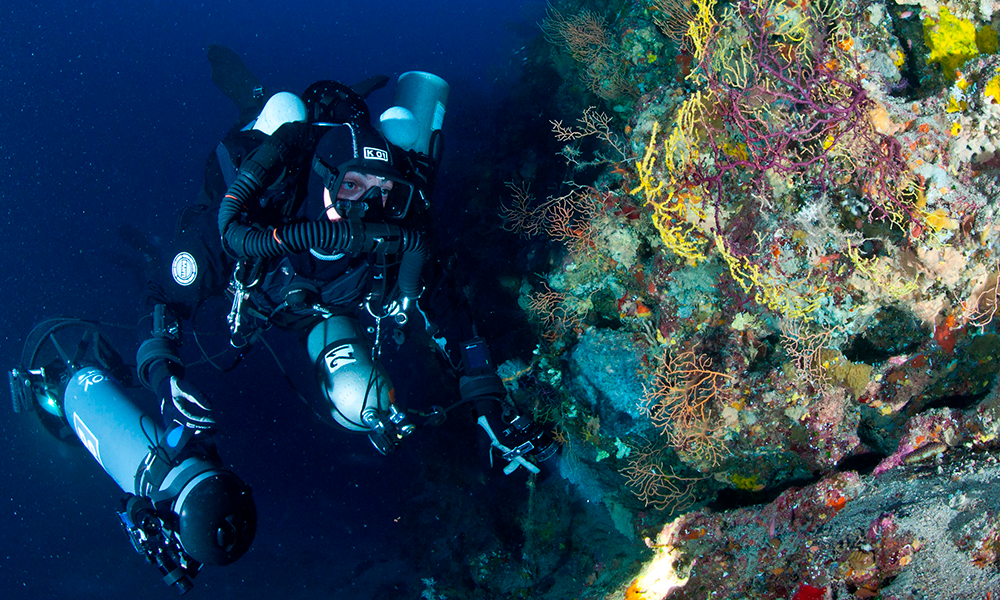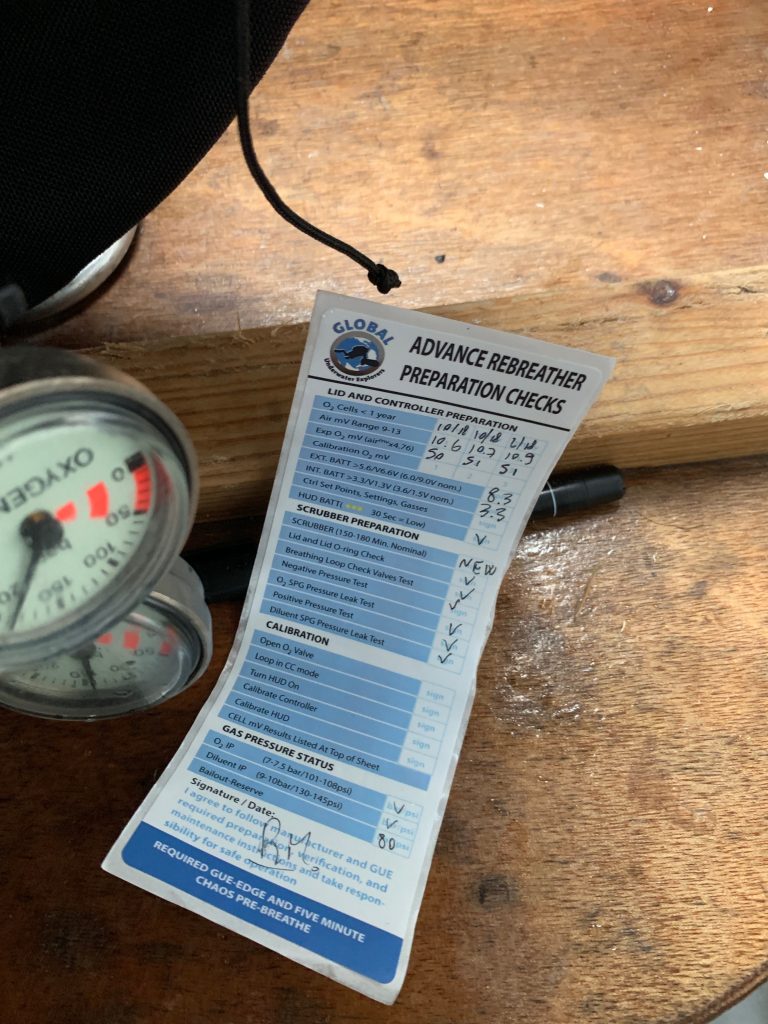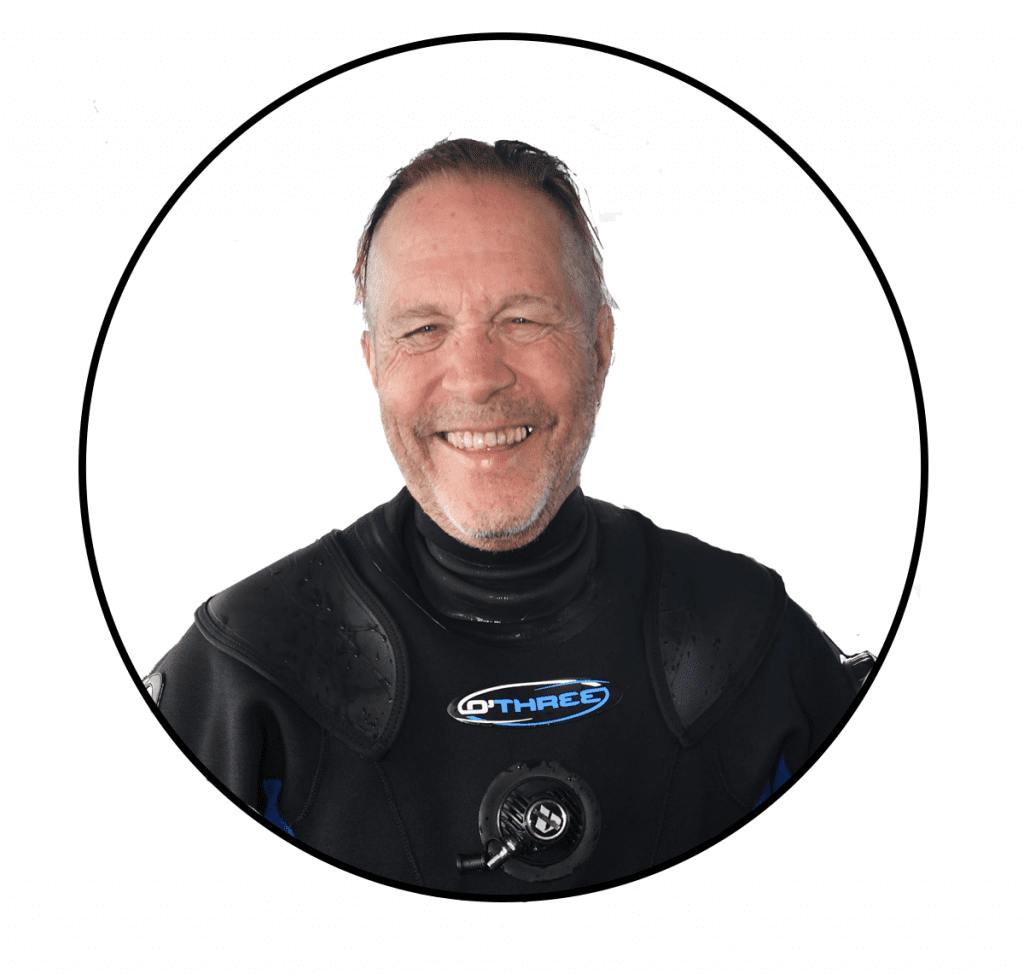Community
Dive, Learn, Eat: Rebreather Meeting in Italy
How would you like to spend four days with a group of passionate adventurers on an island in southern Italy, diving rebreathers on submerged seamounts, getting briefed by some of the biggest diving brains on the planet, and eating to your heart’s content? Thought so! Unfortunately, you missed it. But here are the some of the highlights and takeaways presented by InDEPTH chief Michael Menduno who was in attendance. Hey someone had to go.

by Michael Menduno. Lead photo by Marco Sieni.
May 1, 2019—Nearly three dozen rebreather aficionados made the biannual trek to Ponza, Italy, a picturesque island in the Tyrrhenian Sea about a three-hour journey from Rome. They were there for the sixth International Rebreather Meeting organized by Andrea Donati, owner of Ponza Diving Center, and his partner Daniela Spaziani. The goal of the four-day meeting, which was sponsored by a number of manufacturers and organizations, including JJ CCR, Shearwater, DAN Europe, Società Italiana Medicina Subacquea e Iperbarica (SIMI), and the Italian rebreather users’ association CCR Italia, was to provide the latest research and information to the rebreather community.

“They’re passionate tech divers hungry for information,” explained Dr. Simon Mitchell, a professor of anesthesiology at the University of Auckland, New Zealand, who was one of the presenters. “That’s what I love about these types of meetings. I am happy to be here and share what I know.”
Taking a cue from the hyperbaric medical community, the meeting was organized to appeal to diver sensibilities; diving in the morning (8:30 a.m.- 2:00 p.m.), and lectures and discussion in the afternoon (3:00 p.m. – 7:00 p.m.) followed by dinner and drinks (9:00p.m. – 11:30 p.m. or later).
Dive Right In!
Donati and his crew did a masterful job of supporting more than twenty rebreather divers bearing scooters, cameras, and bailout bottles, along with a few open circuit divers, without incident. Their enthusiastic attitude and thoughtful attention to detail, whether it was solving specific problems with individual’s rebreathers, or bringing in attendees dry suit underwear hanging on the exterior of the boat before the after dinner rain hit, helped the operation run smoothly and efficiently while feeling relaxed. They were aided by Ponza Diving’s ubiquitous mascot, an amicable large black matif named Ugo.
The boat, which was docked just outside of the dive shop, headed out each morning around 8:30 a.m., as divers huddled over Italian espresso and fresh bread after prepping their breathers. Interestingly, as we were loading up the boat on the first day there, Donati made a point of warning both me and Peter Symes, publisher of X-Ray magazine, to go easy on the coffee. “It can kill you,” he said with all seriousness, citing an American diver who had a heart attack underwater after consuming too many cups of espresso. The boat then made its way to one of the numerous submerged seamounts covered in soft corals surrounding the island, where it would anchor for the morning dive.

Our morning dives were typically 165-261 ft/50-80m deep with one-to-two-hour run times. Visibility was 50-65 ft/15-20 m and water temperature was about 58-60°F/15-16°C. Following each dive, we were treated to a multi-course lunch, which usually included soup, fish, cephalopods, rice, pasta, bread, salad, and dessert, along with the requisite pitcher of wine and more espresso. After lunch, the boat headed back to port, where we prepped gear for the next day’s dive.
Where’s The Manzo, err Beef?
While rebreather diving in Ponza was clearly the attraction that brought people together, the presentations, given by some of the community’s leading scientists, engineers, and practitioners were the meat of the meeting. (Are you detecting a pattern here?) Our group met in an old stone chapel up the hill from the dive shop. Headphones were available for sequential English and Italian translation.
One of the themes that emerged from the meeting was the role of human factors, i.e. the way we process and act on and or fail to act on information, and its impact on diving safety. This is a deep body of knowledge that was developed in the aviation and healthcare fields and is now being applied to diving largely through the efforts of pioneer Gareth Lock at The Human Diver. Several of us noted that human factors were being discussed in the absence of the seemingly ubiquitous Lock, was a sign that this important work was beginning to gain traction. Here are some of the highlights.

Training Doesn’t Work: Technical Diving International (TDI) Rebreather Instructor, Instructor Trainer, and author Mark Powell began with a list of ten improvements in rebreather diving that he would like to see from a community perspective; things like better buoyancy control, the increased use of checklists, and more attention to bailout planning. He then asked the question, “Why hasn’t training made a difference?” That is, why hasn’t training produced permanent observable changes in divers’ behavior in these areas? The answer, documented by numerous studies, is that humans aren’t very good at retaining information.
The solution: deliberate practice of essential skills. “People tend to practice things they like and are good at, which is not very helpful,” Powell explained, noting that practicing things that are very difficult to do doesn’t work either. “The sweet spot,” he said, “is practicing things that are challenging.” He recommended that divers practice something on every dive! Sounded very GUE to me.
In-water Recompression (IWR): The use of in-water recompression to treat divers at remote locations has long been controversial, and until recently the hyperbaric medical community has failed to reach a conclusion regarding its efficacy. But as Simon Mitchell explained, the situation has now changed as a result of a new paper, “In-Water Recompression”, he co-authored with Dr. David Doolette, a decompression physiologist at the U.S. Navy Experimental Diving Unit (and a GUE diver). The two were able to find evidence not previously reported that answers two key questions:
- Does early recompression improve outcomes? (i.e. recompressing an injured diver within minutes vs hours)
- Is shallower, shorter recompression effective? (Note that IWR typically compresses the diver on 100% oxygen to 30 ft/9 m vs. a USN Table 6 to 60 ft/18 m.)
Based on U.S. Navy data derived in part from early research on treatment protocols, Mitchell and Doolette were able to answer both questions strongly in the affirmative. The new recommendation: A diver should be treated with IWR if a chamber is more than two hours away and the team is set up to provide IWR (i.e. has proper equipment such as full face mask and training, support, environmental conditions, and appropriate patent status).
Defensive Dive Profiling/Concerns for Aging Divers
Dr. Neal Pollock, research chair in hyperbaric and diving medicine at Université Laval, gave a pair of eye-opening lectures on the potential long-term impacts of decompression stress, what can be done, and the prospects for aging divers. Was he talking about us?

Pollock began by citing studies that found lesions in the brain and spinal cord have been observed with higher frequency in individuals with a history of repeated decompression stress. Bone lesions have also been found in commercial divers. The factors shown to increase the risk of dysbaric osteonecrosis in commercial divers were: a history of inadequate or experimental decompression, diving deeper than 165 ft/50 m, and a history of decompression sickness (DCS). The conclusion: while dysbaric osteonecrosis has largely been eliminated in commercial diving due to procedural changes, decompression stress poses a potential long-term risk factor for technical divers! Divers need to think about immediate and long-term risk.
As a result, Pollock, who is known for doing extra deco, encouraged divers to do longer shallow decompression adding, “It can’t hurt. It can only help.” Specifically, he recommended several ways of adding conservatism: using conservative gradient factors, primarily reducing GF-high, buffering the dive by slowing down on the final ascent to the surface following the last high pO2 stop, delaying exercise post-dive, extending surface intervals to add more time for recovery, using appropriate gasses (Yes, “air is for tires!”), choosing appropriate partners with similar risk tolerances, and maintaining good physical fitness.
The bottom line for aging divers; there is no upper age limit, though there may come a point where you need greater support. Be forewarned! Note, there were several post 65-year-old divers making the plunge at Ponza!

Human Factors In Rebreather Diving: Mitchell began by noting that human factors were the most important, but also the hardest, path to improving safety in rebreather diving. He then posed the question: Is there a safety problem with rebreather diving?
Mitchell began by reviewing what we know about rebreather safety based on the ground-breaking 2012 paper by Dr. Andrew Fock analyzing recreational rebreather deaths 1998-2010, to wit: There were approximately 20 deaths/year for 2000-2010 from a population, which was then estimated to be about 18,000 rebreather divers based on agency certifications. That means that the fatality rate for rebreather diving was estimated to be about 133 deaths/100,000 divers/year compared to about 16 deaths/100,000 divers/year for open circuit diving. The conclusion: rebreather diving was about 10x more hazardous than open circuit scuba. Note, there is currently a follow up study underway to determine if things have improved.
Mitchell broke down the causes of rebreather fatalities into three buckets:
• Hazards of advanced diving
• Rebreather equipment failures
• Diver error and violations
Overwhelmingly, most incidents arose from diver errors (Trying to do the right thing but doing the wrong thing) and violations (Knowingly creating unnecessary risk of harm to yourself and others, and expecting to get away with it). “I have made errors and violations in my rebreather diving,” Mitchell offered to the assembled group of divers, “and I bet you have too.”
What’s to be done?
Mitchell reviewed several fatalities involving violations, like diving with two-year old oxygen sensors, or using a type of sorb not specified by the manufacturer. He said that we needed to remove the motivation for violations. This involves a culture change: Make safe choices be seen as a strength versus a weakness. Training, mentoring, and role modeling are critical in this regard.
Typical errors might include forgetting to analyze one’s gas, forgetting to turn on the rebreather or open the oxygen valve, or leaving out an O-ring on the scrubber. In fact, each of these errors has resulted in multiple fatalities. Mitchell said that pre-dive checklists are the primary means for preventing errors. As a testament to the power, he cited a study analyzing the impact of using checklists in surgical suites: Deaths were reduced by 50% after the introduction of checklists, and as Mitchell pointed out, these were among highly trained professionals. He then cited a DAN study of some 2041 dives examining the impact of pre-dive checklist use on scuba mishaps; mishaps, including rapid ascents and low/out of air were reduced by 36%.

The barriers to using checklists?
First, misunderstanding about their purpose; checklists are not meant to replace a manual! Second, arrogance/ignorance; I can do it from memory, or I don’t make mistakes. Checklists can be supported by training, practice, and engineering.
Interestingly, after the meeting I asked one of the Italian rebreather divers if he used a checklist on our dives. “My instructor taught me to do it by memory,” the diver told me, “So that is what I do. I haven’t had any problems.” Until he does, and therein lies the problem.
Bruce Partridge, founder of Shearwater Research, also focused his talk on human factors and changing divers’ behaviors. He began by talking a little about the history of Shearwater, which got it start making rebreather controllers before venturing into dive computers. He then discussed the work involved in assuring that rebreather sub-systems like controllers meet safety requirements as part of the CE 14143 standard, which they published in a 2013 IEEE paper. Partridge said he believed that the CE 14134 standard was a really good thing for the rebreather industry. Interestingly, he pointed that there were approximately 600 failure modes possible on a rebreather, however, only 40 were equipment related; the remainder involve diver errors.
Explorer Edoardo Pavia, owner of Sea Dweller Divers, also spoke passionately about rebreather safety in light of human factors from his personal experiences. He began by speaking about British expedition leader Carl Spencer’s tragic death on the 2009 Britannic Expedition. Spencer mistakenly breathed an unmarked, high-oxygen content bailout cylinder at depth and convulsed and drowned. Pavia shared his views about the importance of following manufacturers’ rules and recommendations regarding checklists, oxygen sensors lifetime, scrubber duration, using proper sorb, and the importance of bailout out valves (BOV). He concluded that ignorance was “the hardest monster to defeat.”
DCI Research/Telemedicine
Massimo “Max” Pieri, research supervisor for DAN Europe, presented their research focusing on preventing decompression illness (DCI) using DAN’s diving database of some 66,000 dives ranging in depth from 16-628 ft/5-192 m, average depth 100 ft/30 m. Some of the factors they have considered include: gradient factors, hydration, genetic disposition, and hematological parameters. They are also conducting a decompression study with a local (Italian) GUE group in cooperation with instructor Mario Arena, examining the efficacy of so-called “deep stops” vs shallow decompression profiles [See Dr. David Doolette’s post, “Gradient Factors in a Post-Deep Stops World,” in this blog issue for additional data].
Next, DAN Europe president Dr. Alessandro Marroni discussed his visionary program dubbed Advanced Virtually Assisted Telemedicine in Adverse Remoteness (AVATAR). Their goal is to develop tools and procedures to enable real-time monitoring of divers during their dives—think Fitbits on steroids! Marroni described his vision of a DAN doctor able to assess a diver who’s still in the water, and communicate directly with that diver via an underwater communications system. In fact, they have already tested prototypes.

Dott. Pasquale Longobardi, president of SIMI, also presented SIMI’s research examining the biochemical mechanisms involved in decompression stress. He concluded with a set of best practices, namely to run pO2s at 1.3 bar or less, maintain pN2s at 3.16 bar (the equivalent of breathing air at 100 ft/30 m) or less and run pHe as high as possible; Longobardi stated that helium in the form of trimix protects divers from oxidative stress (inflammation) compared to diving air (kick those tires again!). A colleague in the audience told me he had questions about the supporting data.
Mangia Mangia
Having gotten our daily dose of brain food, attendees retired to their hotels and apartments to catch up on email, clean up, and later walk to the ristorante du jour that had been chosen for that evening. There we were greeted by our attentive hosts, Andrea and Daniela, accompanied by Ugo, who had arranged for a family-style dinner with wine and made sure that everyone had enough to eat and drink. If you had trekked to the meeting for the food alone, you would have not been disappointed.

“Mangia,” Dani told me gesturing emphatically with her hands and pointing to my empty plate, after the second, or was it the third course? “Please, you must eat some more,” she insisted passing me a bowl of mussels.” It felt like a family gathering—a family of passionate, geeky divers who were there to commune with their peers in celebration of l’arte e pratica che amiamo. And the eating and drinking and sharing of stories continued into the night.
Header Image: Marco Sieni.
Dive Deeper:
InDEPTH: Come to the Ponza Rebreather Meeting 8–12MAY 2024

Michael Menduno is InDepth’s executive editor and, an award-winning reporter and technologist who has written about diving and diving technology for 30 years. He coined the term “technical diving.” His magazine “aquaCORPS: The Journal for Technical Diving”(1990-1996), helped usher tech diving into mainstream sports diving. He also produced the first Tek, EUROTek, and ASIATek conferences, and organized Rebreather Forums 1.0 and 2.0. Michael received the OZTEKMedia Excellence Award in 2011, the EUROTek Lifetime Achievement Award in 2012 and the TEKDive USA Media Award in 2018.






















































